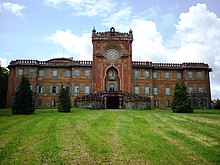User:Calliopejen1/WIP/Sammezzano Castle





Sammezzano Castle is a Moorish Revival castle in Leccio, Reggello Municipality, Florence Province, Italy. The castle's present structure dates to the 17th or early 18th century, and its interior dates to the 19th century.[1] The castle has existed in one form or another for over a millennium.[1]
PD source in Italian:[2]
SAN MEZZANO o SAMMEZZANO nella Valle dell' Arno superiore. - Villa e tenuta signorile del marchese Panciatichi, già Ximenes, nel popolo di S. Salvatore al Leccio, Comune, Giur. civile e circa 3 miglia a pon. di Reggello, Dioc. di Fiesole, Comp. di Firenze.
Siede la villa di Sammezzano in poggio, a cavaliere della nuova strada regia postale Perugina, in mezzo ad una vasta tenuta posta tra il torr. Chiesimone a lev. ed il Vicano di S. Ellero; la qual tenuta è compresa nel piviere di Casciano ed ha circa 7000 strora di terreno con circa 2 poderi ed una cascina.
La qual tenuta apparteneva a Bindo Altaviti, allorchè Cosimo I lo dichiarò ribelle e gli confiscò tutti i suoi beni.
Nel 1558, cioè tre anni dopo il sequestro fiscale di questa tenuta, i monaci e l’abate di Vallombrosa tentarono di muover lite al fisco del duca Cosimo, protestando di aver essi dei diritti sopra Sammezzano, a cagione di una permuta fatta fino del 1487 od 88 con due fratelli Gualterotti, allora possessori della tenuta predetta.
Non è da dire chi vincesse la lite, mentre ai monaci mancava quello che ebbe Federigo re di Prussia, il quale fece fondere nella culatta de' suoi cannoni coteste espressive parole: ultima ratio regis. Che sebbene i monaci di Vallambrosa ottenessero la prima sentenza favorevole, essa fu ben presto revocata dalla Ruota fiorentina nel 18 settembre del 1590.
Innanzi però fa conceduta la tenuta di Sammezzano al marchese Medici di Mariguano, stato generale del duca all'assedio e conquista di Siena.
Qualche tempo dopo il marchese di Marignano volendo ritornare a Milano cedè al nuovo granduca di Toscana la tenuta di Sammezzano con gli altri beni di suolo e fu dallo stesso granduca Ferdinando I che nel 1605 il cavaliere Ferdinando Ximenes d'Aragona comprò la fattoria e annessi di Sammezzano per 39,000 scudi fiorentini. Quindi il senatore Ferdinando Ximenes, favorito del granduca Cosimo I, ridusse la casa torrita di Sammezzano alla forma di palazzo di campagna con giardino, viali e statue.
Estinta che fu la linea Ximenes d'Aragona nel 1816, la tenuta in discorso passò nei marchesi Panciatichi di Firenze nati da una Ximenes sorella dell'ultimo Ferdinando Ximenes.
Machine translation:
SAN MEZZANO or Sammezzano in the Valle dell 'Arno higher. - Villa and stately home of the march. Panciatichi formerly Ximenes, in the parish of San Salvatore al Leccio, Com, Jur. Civil and about 3 miles pon. of Reggello, Dioc. Fiesole, Florence Comp.
The villa sits in Sammezzano hillock astride the new road direction post Perugia, in the midst of a vast estate located between the torr. Chiesimone to lev. and Vicano of Sant'Ellero; the estate which is included in the parish of Casciano and has about 7000 strora of land with about 2 farms and a dairy farm.
The estate which belonged to Bindo Altaviti, when Cosimo I declared him a rebel and confiscated all his possessions.
In 1558, three years after the seizure of the estate tax, the monks and the abbot of Vallombrosa tried to wage dispute to the tax authorities of Duke Cosimo, protesting that they have rights over Sammezzano, on account of an exchange made up of 1487 or 88 with two brothers Gualterotti, then owners of the estate aforesaid.
It is not to say who would win the fight, while the monks lacked what was Frederick, King of Prussia, who had to merge into the breech de 'his guns coteste expressive words: ultima ratio regis. That although the monks of Vallambrosa they got the first favorable ruling, it was soon withdrawn from the Wheel of Florence in the 18th September 1590.
First, however, is bestowed the estate of Sammezzano to march. Doctors Mariguano, was the siege and conquest of the Duke of Siena.
Some time after the march. of Marignano wanting to return to Milan surrendered to the new Grand Duke of Tuscany seal Sammezzano with other goods of the same ground and was Grand Duke Ferdinand I in 1605 that the knight Ferdinando Ximenes d'Aragona bought the farmhouse and outbuildings Sammezzano for 39,000 crowns Florentine . So Senator Ferdinand Ximenes, favorite of Grand Duke Cosimo I, reduced the home torrita Sammezzano the form of country mansion with gardens, statues and avenues.
That the line was extinguished Ximenes d'Aragona in 1816, the estate passed into the speech of the Marquis Panciatichi Florence born to a sister of the last Ximenes Ferdinando Ximenes.
As of the late 15th century, the Gualterotti brothers owned the estate. The estate belonged to banker Bindo Altoviti in 1555, when Cosimo I de' Medici declared Altoviti a rebel and confiscated all his possessions. Cosimo I gave the estate to Gian Giacomo Medici as a gift. In the late 16th century, the monks and the abbot of Vallombrosa unsuccessfully claimed rights over the estate based on an alleged agreement in 1487 or 1488 with the Gualterotti brothers.
References[edit]
- ^ a b McCorquodale, Charles (April 1981). "A Tuscan Alhambra". The Connoisseur. 206 (830): 272–275.
- ^ http://books.google.com/books?id=9-E4OHVVoIQC&pg=PA1213&dq=Sammezzano+castello&hl=en&sa=X&ei=piN1U-inBc32oASZ7YCYBw&ved=0CD0Q6AEwAg#v=onepage&q=Sammezzano%20castello&f=true
